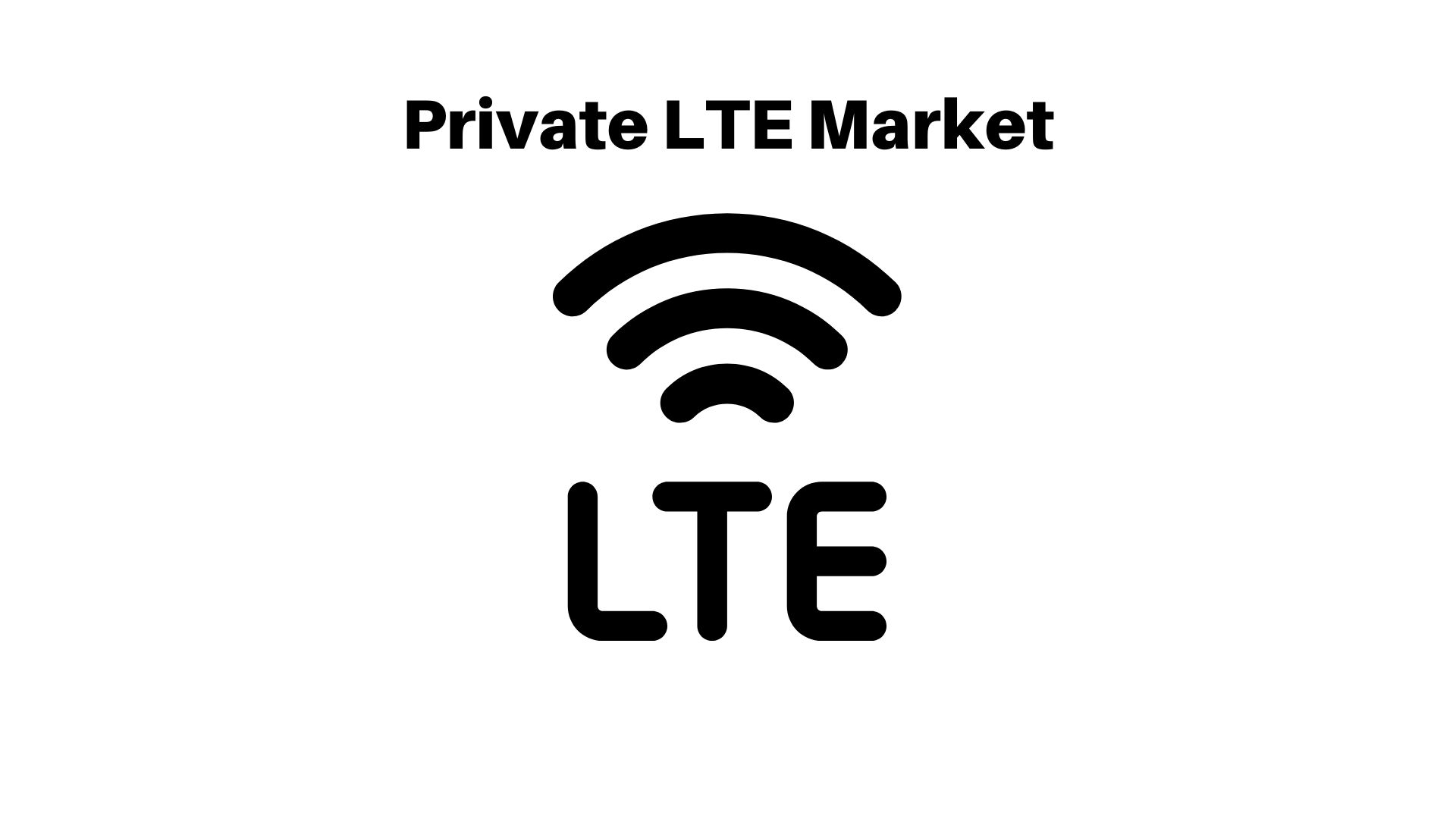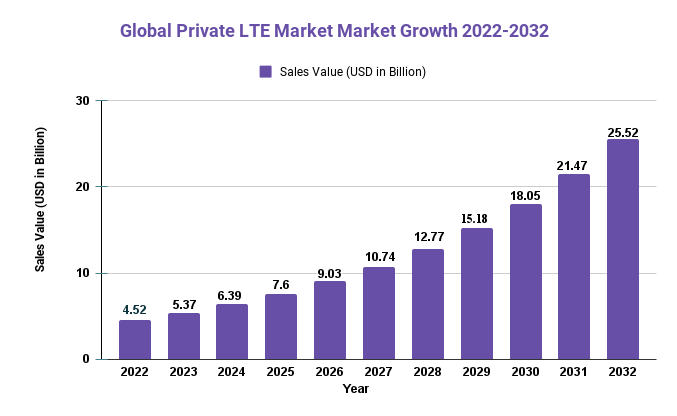Global Private LTE Market Report Offers In-Depth Analysis +Growth Rate 18.9% by 2032

Page Contents
Market Overview
Published Via 11Press: By 2022, the Private LTE market had seen rapid growth and was expected to keep increasing over the coming years. Private LTE refers to using Long Term Evolution (LTE) wireless communication technology within a secured network environment – usually for the exclusive use of one organization or group.
Market.us reported that the global Private LTE market size was valued at USD 4.52 billion in 2022 and is projected to reach USD 25.52 billion by 2032, growing at an annual compound growth rate (CAGR) of 18.9% over this forecast period.
The report attributes the growth of the Private LTE market to several factors, including an increasing need for reliable and secure communication networks, the growing adoption of connected devices and the Internet of Things (IoT), as well as high-speed connectivity in industrial applications.
North America was forecast to hold the largest market share in Private LTE, followed by Europe and Asia Pacific. Additionally, demand for Private LTE was particularly strong across industries such as transportation, energy & utilities, and public safety.
Request For Sample Report: https://market.us/report/private-lte-market/request-sample
Key Takeaway
- Private LTE is projected to experience rapid growth between 2020-2025, with an annual compound growth rate (CAGR) of 18.9%.
- This market is being driven by the rising adoption of IoT and an increasing need for reliable and secure communication networks.
- North America is expected to be the leading market, followed by Europe and Asia Pacific.
- Major industries such as transportation, energy and utilities should embrace private LTE technology.
- Asia Pacific's private LTE market will experience rapid growth due to an escalating IoT adoption in countries like India and China.
- For the Rest of the World's LTE market, moderate growth is predicted due to the widespread adoption of advanced communication systems in Middle East/Africa.

Regional Snapshot
- North America is expected to hold the largest market shares due to high adoption rates of advanced technologies and the presence of key players in this region. With an expansive industrial sector and high demand for advanced communication solutions in the United States, Private LTE services are expected to become highly sought-after across North American.
- Europe was projected to be the second-largest private LTE market, driven by rising demand for advanced communication technologies in both commercial and industrial sectors. Furthermore, IoT (and connected devices) will likely drive significant expansion within this region.
- Asia Pacific is forecasted to experience the fastest growth in the Private LTE Market. This is largely due to an increased adoption of IoT (and connected devices) in countries like India and China. Furthermore, advanced communications networks were expected to become more prevalent across various industries such as transport, energy, and utilities.
Drivers
- Growing demand for reliable and secure communications networks: Private LTE networks offer a higher level of security and reliability than traditional wireless networks. This makes LTE networks attractive to transport, energy, and other industries as well as public safety.
- IoT and connected device adoption are increasing: Private LTE networks provide high-speed, reliable, and affordable connectivity for IoT devices.
- Need for high-speed internet connectivity in industrial applications
- Rapidly Growing Demand for Mobile Broadband: As the demand for high-speed mobile broadband continues to increase, Private LTE networks offer businesses and organizations a reliable and cost-effective solution.
- Government Support for Advanced Communications Solutions: Governments around the world are investing in advanced communication solutions to protect critical infrastructure and public safety. Private LTE networks are ideal for this role due to their superior security and dependability.
- Unmanned Aerial Vehicles (UAVs): As UAVs become more widely utilized for surveillance and inspection tasks, there is an increasing need for high-speed and low-latency networks – which can be efficiently provided by Private LTE networks.
Restraints
- High Deployment Costs: Private LTE networks require a substantial up-front investment, including hardware, software, and infrastructure. This can be a significant barrier to adoption – particularly for smaller organizations.
- Regulatory Obstacles: Deployment of Private LTE networks may face regulatory obstacles such as spectrum availability, licensing requirements, and compliance with local regulations. This can cause delays and raise costs significantly.
- Competition from Other Wireless Technologies: Private LTE networks must contend with competition from other wireless technologies like Wi-Fi, Bluetooth, and cellular networks. In certain use cases, these alternatives may offer greater cost efficiency which could limit the growth of the Private LTE market.
- Lack of Skilled Workforce: Deploying and maintaining Private LTE networks necessitate specialized skills and expertise which may not be available in some regions. This could restrict market expansion, especially in developing nations.
- Interoperability Issues: Interoperability issues between Private LTE networks and legacy communication systems may arise, which could limit the adoption of Private LTE in certain industries.
Opportunities
- Increasing Demand for Smart City Solutions: As more cities adopt smart city technologies, there is an increasing need for reliable and secure communication networks. Private LTE networks offer a cost-effective and scalable solution to various smart city applications such as public safety, traffic management, and smart lighting.
- The emergence of 5G Technology: The arrival of 5G technology is expected to drive the adoption of Private LTE networks, as 5G requires dense and high-capacity connections for supporting advanced applications like autonomous vehicles, smart factories, and remote healthcare.
- Drone Use Increases: With the growing use of drones across industries such as agriculture, construction, and logistics, there is an urgent need for high-speed and low-latency networks. Private LTE networks offer a reliable and secure solution for drone communication and control.
- Industrial IoT adoption forecast: As industrial IoT applications require low latency and fast networks for real-time monitoring and control, demand for Private LTE networks is expected to increase.
- Expansion of Connected Car Services: As more connected car services such as infotainment, telematics, and remote vehicle monitoring become available, the need for high-speed and low-latency networks has grown. Private LTE networks offer an effective yet secure solution for this growing communication requirement.
View Detailed TOC of the Report | https://market.us/report/private-lte-market/table-of-content/
Challenges
- Spectrum Accessibility: Private LTE networks require licensed spectrum, which may be scarce or expensive in certain regions. This could restrict their growth potential if the spectrum is in short supply or expensively priced.
- Security Concerns: Although Private LTE networks are expected to be more secure than traditional wireless networks, they remain vulnerable to cyber threats like hacking and data breaches. Thus, protecting Private LTE networks remains a top priority for the industry.
- Lack of Standardization: Without standardization in Private LTE networks, organizations may find it difficult to integrate various systems and devices. This restricts interoperability between these networks, making it harder for organizations to adopt the technology.
- Integration with Legacy Systems: Integrating Private LTE networks with legacy systems can present a challenge, particularly in industries with complex and highly regulated processes. This may limit the adoption of Private LTE networks in certain sectors.
- Cost: Private LTE networks require a significant upfront investment, which may be a deterrent for some organizations. Furthermore, their cost may limit their adoption in developing regions and smaller organizations due to their prohibitive nature.
- Skilled Workforce: Implementing and supporting Private LTE networks necessitates a highly experienced staff with specialized knowledge. Unfortunately, the shortage of skilled workers in this area may make it challenging for organizations to adopt Private LTE networks.
Key Market Segments
Type
- LTE-TDD (long-term evolution time division duplex)
- LTE-FDD (long-term evolution frequency division duplex)
Application
- Transportation
- Military and Defense
- Manufacturing and Industrial
- Oil and Gas
- Energy and Mining
- Healthcare
- Others
Key Market Players
- Nokia
- Huawei Technologies Co. Ltd.
- Qualcomm Technologies Inc.
- Ruckus Networks
- Future Technologies
- Ambra Solutions inc.
- Comba Telecom Systems Holdings Ltd.
- AIR-LYNX.
Report Scope
| Report Attribute | Details |
| The market size value in 2022 | USD 4.52 Bn |
| Revenue forecast by 2032 | USD 25.52 Bn |
| Growth Rate | CAGR Of 18.9% |
| Regions Covered | North America, Europe, Asia Pacific, Latin America, and Middle East & Africa, and Rest of the World |
| Historical Years | 2017-2022 |
| Base Year | 2022 |
| Estimated Year | 2023 |
| Short-Term Projection Year | 2028 |
| Long-Term Projected Year | 2032 |
Recent Development
- Partnerships and collaborations: Many companies operating in the Private LTE market have formed alliances and collaborated to improve their capabilities and offerings. Ericsson, for example, announced a partnership in February 2022 with Nokia to provide Private LTE and 5G networks to enterprises and industries.
- Security has become a more important concern: There is a growing concern about cyber threats and data breaches. Private LTE security has seen an increase in importance. Security solutions and technologies are being invested in by many companies to protect their data and networks.
Frequently Asked Question
Q: What is the current market size for the Private LTE market?
A: According to a report by Market.us, the Private LTE market was valued at USD 4.52 billion in 2022 and is expected to reach USD 25.52 billion by 2032, growing at a CAGR of 18.9% during the forecast period.
Q: What are the key segments of the Private LTE market?
A: The Private LTE market can be segmented based on type (LTE-TDD (long-term evolution time division duplex), LTE-FDD (long-term evolution frequency division duplex)), Application (Transportation, Military and Defense, Manufacturing, and Industrial, Oil and Gas, Energy and Mining, Healthcare, Others), and geography (North America, Europe, Asia-Pacific, Latin America, and Middle East & Africa).
Q: Who are the key players in the Private LTE market?
A: Some of the key players in the Private LTE market include Nokia, Huawei Technologies Co. Ltd., Qualcomm Technologies Inc., Ruckus Networks, Future Technologies, Ambra Solutions inc., Comba Telecom Systems Holdings Ltd., and AIR-LYNX.
The team behind market.us, marketresearch.biz, market.biz and more. Our purpose is to keep our customers ahead of the game with regard to the markets. They may fluctuate up or down, but we will help you to stay ahead of the curve in these market fluctuations. Our consistent growth and ability to deliver in-depth analyses and market insight has engaged genuine market players. They have faith in us to offer the data and information they require to make balanced and decisive marketing decisions.



